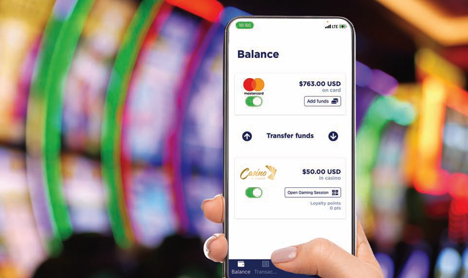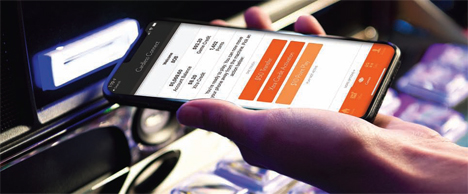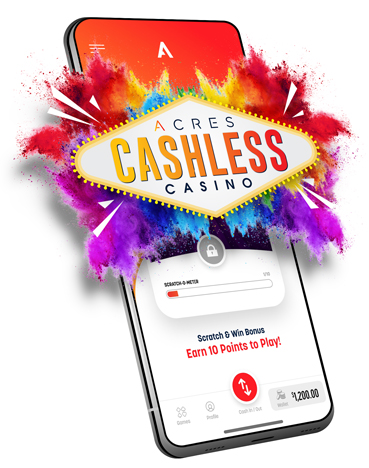
In June 2021, Resorts World Las Vegas opened the first casino with cashless wagering available across the floor. Once a player creates a wagering account integral to the Genting Rewards loyalty club, patrons can use their smartcards to fund their gaming experience.
The Resorts World system, powered by Sightline Payments’ Play+ technology working in concert with the Konami Synkros casino management system, is seamless once it’s up and running. For the technologically challenged, though, the process of signing up is not without its hiccups. The casino has ambassadors wandering the floor offering to help players set up their accounts, which must be done through one of the Genting Rewards kiosks. Nevada requires physical ID for cashless gaming, so players must scan their driver’s license or passport at the kiosk.
Early on, this caused friction for some players. However, the end result is that players can simply fund their gaming on slots or tables. (At the tables, players simply tap their cards or phone on a tablet to get chips.) There are now several choices to implement cashless gaming, and the process depends largely on the technology being used.
Educating players on cashless technology has taken many forms, from kiosks to signage to ambassadors roaming the floor. Some are doing this more effectively than others.
Take IGT’s system, Resort Wallet with IGTPay. Resort Wallet is the digital wallet from which players draw funds; IGTPay is the company’s proprietary external funding gateway. The system is part of IGT’s Advantage casino management system. The cashless setup has processed over 2 billion transactions since it was brought to the U.S. (IGT has deployed it internationally for 15 years.)
The IGT system has been deployed by Station Casinos since July 2021, and went live at Oklahoma’s Indigo Sky in July 2022.
Jacob Lanning, IGT senior director of business development, payments, says the casinos are easing the customer transition to cashless in several ways.
“The most important thing that they can do is to put up signage in and around the places where a customer could use that technology to spend,” he says. “Using Station as an example, they placed little stickers next to the bill validator on every single slot machine that supports the cashless solution across all of their six major properties.
“They put signage at the points that they can enroll. They do overhead signage as well across the floors. They have digital billboards out on the front of their property. From a signage perspective, they try and communicate it through as many different touchpoints as possible.”

IGT Resort Wallet
Station, like Resorts World, is also using ambassadors. “These are people that are specifically trained in how the solution works, and the advantages and opportunities that players can have,” Lanning says. “They roam around the casino floors and talk to different players and tell them about the solution, and then walk them through the enrollment process, and get them onboarded. “That’s been the most successful way of them getting players into the ecosystem—through the ambassador programs.”
One of the fastest-growing cashless programs is the one deployed by Penn Entertainment, which at this writing has converted 11 of its 37 properties to the cashless technology, deployed via Acres Manufacturing’s Casino Cashless all-in-one solution. According to Richard Primus, senior vice president and chief information officer for Penn Entertainment, the deployment will continue at a brisk pace.
“I believe cashless will be live in 21 of our 37 properties by the beginning of 2024,” Primus says, “and they’ll be a roadmap for 2024 to continue extending the footprint.”
Penn has developed an extensive program for educating players and for marketing the technology to foster adoption of cashless. “We work very closely with our property, operations and marketing teams as well as our friends in corporate marketing,” Primus says. “We build awareness campaigns prior to launch, during launch and post-launch to try to get a lot of good momentum with our customer base.
“And the key is raising that awareness, because you want them to try it several times. Once you get them to use it several times, then the adoption rates and the stickiness are considerably higher.”
Todd George, executive vice president, operations for Penn Entertainment, adds that Penn has been successful in creating trial by requiring cashless enrollment to “unlock” certain games. “If you want get on (certain) lower-denomination games, it will require cashless technology to get on that game, or if you want to play on some specific banks of slots, you’ll have to do it through cashless,” George says. “Again, it involves creating trial opportunities and unlocking experiences, and it’s been really well received on the floor.”
As far as the physical impact on the look of the floor, Primus says it is “negligible,” other than the look of the card reader. “The card reader looks a little different, but it also accepts the regular player’s card,” he says. “So, we’re not prohibiting anybody from using traditional methods.”
Instead of ambassadors, Penn is using an innovative alteration to its casino floor to help the technologically challenged to get enrolled. “We’ve established loyalty centers,” Primus says. “Think of it almost like an Apple Genius Bar, where we’ve got dedicated space on our floor with people who are very conversant in the technology to invite players in to come and have a high-touch experience of initial setup and enrollment. Or if somebody’s walking by and they become interested, they can go in and talk to somebody about the technology and the capabilities, and employees will walk them through in a much more one-on-one experience.”
Ambassadors also visit lines at TITO redemption kiosks and ATMs to educate players. “Once we started putting ambassadors in those lines and showing players how easy it was, that led to adoption,” George says.
Of course, savvy players don’t have to go to a kiosk or a loyalty center to enroll. “It’s 100 percent driven through our loyalty app,” says George. “The only way you can access our cashless technology is through our MyChoice loyalty app that we released earlier in 2021.” He says players with the loyalty app can scan their driver’s license on their smartphone to satisfy the physical ID requirement.
Agnostic Solution
 Many of Penn’s properties use the Acres cashless solution in concert with the Everi CashClub Wallet technology. Everi’s system, in fact, interfaces with the technology of several different cashless solutions providers.
Many of Penn’s properties use the Acres cashless solution in concert with the Everi CashClub Wallet technology. Everi’s system, in fact, interfaces with the technology of several different cashless solutions providers.
For Everi, the system-agnostic solution is a function of the fact the company already provides cash access services at some 750 casinos. “We’re not starting from scratch,” says Victor Newsom, senior vice president, product management and payment solutions for Everi. “We didn’t really reinvent the wheel; we already have the wheel.
“We have infrastructure already present across those floors for credit card, cash and debit card, check cashing and other financial services. So rather than say, ‘Here’s something new,’ we say, ‘Here’s a new transaction pipe on your existing infrastructure that you spent millions deploying and training, and which your customers already know.’”
So far Everi has completely deployed is CashClub Wallet solution at 20 properties, with a target of 60-80 properties by the end of next year, according to Newsom. “I’m working actively across roughly 20 different states right now with the regulators, explaining banking versus cashless wagering versus cashless wagering accounts, helping operators understand strategy.”
He says a few of those jurisdictions—such as the Tribal Gaming Agency, which regulates California’s Sky River Casino—have provisionally agreed to change their regulations to allow fully remote registration.
Newsom says Everi approaches cashless functionality as part of the omnichannel gaming journey. “If you’re doing it the right way, you’ve actually taken all of your assets and created an omnichannel journey where the patron can choose to enter or exit any segment of the journey through whatever channel they want.
“And gaming has historically not supported that. Gaming has said, there’s this regulated system that sits over here. I’m not going to let anything get into it or out of it easily. And then people that come in try to take an e-commerce approach and just bolt it on as a brand new thing.”
He says Everi recommends a different strategy. “Let them go to the kiosk. Let them go to the cage. That’s not where you want to drive them, but that should be a choice. Let them interact on a mobile phone, let them interact with a website. Let them go to the retail location and spend the cash. Or let them go to the game.”
He says 90 percent of patrons so far have chosen to go directly to the end point, the game, for the cashless experience. “But what is interesting is that 10 percent do not,” Newsom says. “They will go to a kiosk and get a TITO ticket because they like gaming with something tangible. Maybe it’s superstition, maybe it’s habit, but it is fact.”
Making it Easy
For operators and solution providers, the end goal in implementing cashless is to make the experience as friction-free as possible.
“Marker Trax’s goal is to make access to cashless casino advances as convenient as possible to players,” says Anamarie Ellis, vice president of operations at Ellis Island Casino in Las Vegas and marketing executive for Marker Trax, the cashless marker system created by the casino. “With that, we utilize infrastructure that already exists on a casino floor—CMS and systems within the games, and mobile phones for players.”
That means cashless wagering using Marker Trax will be virtually invisible to the player, although in the end, it could change the design of casino floors.
“Our product would not take any more physical space on the floor outside of marketing,” Ellis says. “However, as the cashless movement evolves, foot traffic patterns may change (less moving around the floor to go to the cage, waiting in lines at an ATM), which could affect floor layout long term.”
“There are so many touchpoints throughout the casino to promote cashless,” notes Gina Lanphear, director of marketing for Flexia Payments. “However, the most effective opportunities to convert a customer to cashless wagering are the actual locations where the pain points exist in the casino environment—at the cashier, near ATMs and ticket kiosks, and at the slot machines. So, placing signage, digital media and helpful casino staff in these areas to show customers that a seamless, user-friendly cashless experience is as simple as scanning a QR code, registering online and downloading the Flexia Cashless App or the casino’s own in-app digital wallet is extremely effective.”
“While it may seem counterintuitive to try to bridge digital payments and the in-person casino floor, the growing popularization of cashless payments demands that casino operators account for novel payments options when setting up the casino floor,” adds Christopher Justice, president of Global Payments Gaming Solutions.
“With that said, casino operators must still think carefully about how they can blend the two effectively. Many patrons may be aware of cashless payment options but not fully understand how to use them. Casino operators can include educational resources that demonstrate to patrons how to use cashless payments at the casino and encourage them to do so.”
Global Payments increases cashless adoption through its VIP Preferred Concierge program, “a unique, in-person initiative designed to assist patrons in leveraging Global Payments’ industry-standard e-check network,” Justice says. “The VIP Preferred Concierge program has been successful not only in increasing cashless adoption but also in gaining valuable, firsthand feedback from VIP Preferred users.”
Cashless wagering, at least in U.S. casinos, is in its infancy, but as adoption grows, the industry will have a clearer picture of the best way to implement the solutions.
“As the adoption of cashless becomes universal, we’ll see longer game time, less lines and congestion at the cage and loyalty desks, and fewer (or no) ATMs and ticket kiosks,” says Flexia’s Lanphear. “Some of the changes will be invisible to the customer, such as behind-the-scenes reduction of space needed for bill counters, money handling and storage and security features. Combined, this will open space within the casino for new games, retail restaurants or even social areas.”
“The reality is that even getting cash today can be a challenge when you’re not in a casino,” notes Lanning at IGT. “It’s just not something most people carry around that much anymore. You have to make an active decision to get cash. And as the consumer uses less and less cash in their everyday lives and cash just becomes more difficult to get as we move to more of this digitized version of cash, I think players are just going to expect it, because it’s way more convenient than walking around with a pocket full of hundreds.”
“What we’re seeing now with cashless payments in gaming is very similar to the early days of TITO implementation,” comments Justice at Global Payments. “At first, only a few gaming institutions integrated TITO tickets, and its use was very experimental. It took some time for best practices to emerge before the early adopter phase evolved into mass adoption. Now, TITO tickets are commonplace in nearly every casino in America. We are experiencing the same phenomenon with cashless payments.”





